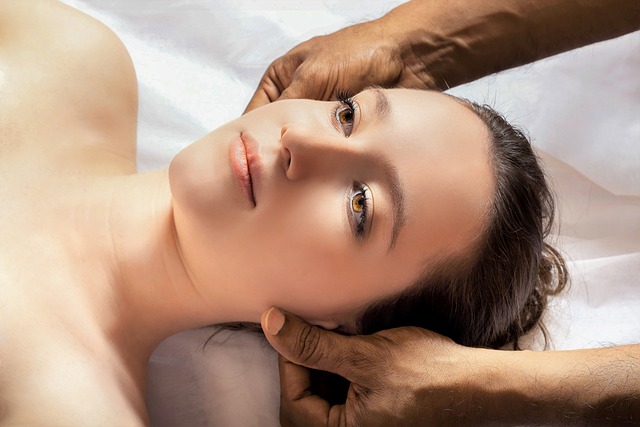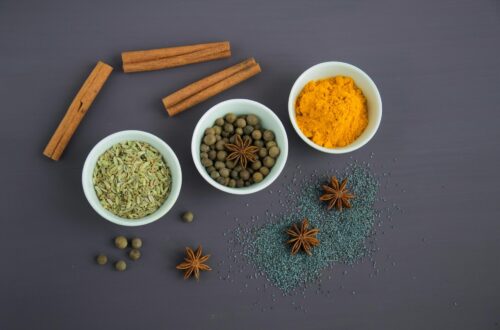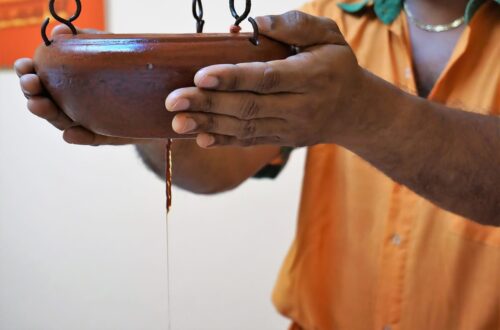
Exploring the Doshas: Vata in Ayurveda
Doshas are the energies that govern our bodies and influence our overall health and well-being. Among the three doshas, Vata holds a special place. It is the force responsible for movement and creativity.
In this blog post, we will delve into the fascinating world of Vata and explore its characteristics, effects on the body, and how to maintain a balanced Vata for optimal health.
Additionally, we will uncover valuable insights into identifying vata dosha within oneself, and provide practical Ayurvedic practices, lifestyle recommendations, herbal remedies, dietary suggestions, yoga, and pranayama techniques, as well as therapies and treatments for addressing vata-related issues.
So, grab a cup of herbal tea, sit back, and Join us on this informative journey to understand and balance the vata dosha in your life
What is Vata?
Vata is often referred to as the “king of doshas” because it governs movement, communication, and creativity in our bodies and minds.
It is responsible for all forms of motion, such as breathing, blood circulation, and the movement of thoughts. Vata is composed of the elements air and space, making it inherently light, mobile, dry, and cold.
Characteristics of Vata:
Vata-dominant individuals tend to embody the qualities of the wind—they are usually energetic, creative, and quick-thinking. These are all reflections of Vata’s qualities.
Individuals with a dominant Vata constitution usually exhibit the following characteristics:
a) Creative and Imaginative:
Vatas have a natural inclination towards creativity. They possess vivid imaginations and often excel in artistic pursuits such as painting, writing, or music.
b) Quick Thinkers:
Vatas are blessed with agile minds, allowing them to grasp new concepts swiftly and make connections effortlessly. However, their thoughts may also scatter easily, making it important for them to cultivate focus.
c) Energetic and Enthusiastic:
Vatas are known for their boundless energy. They often have a zest for life, embracing new experiences with enthusiasm. However, this energy can fluctuate, and it is crucial for Vatas to find balance and avoid burnout.
d) Thin Physique:
Vatas tend to have a slender build and may find it challenging to gain weight. Their bodies are generally flexible, agile, and graceful.
e) Irregular Digestion and Sleep Patterns:
Vatas have a delicate digestive system and may experience irregular appetites and bowel movements. Their sleep patterns can also be disrupted by an active mind.
f) Sensitivity to the Cold:
Vatas are more sensitive to cold weather and may feel discomfort easily. They thrive in warm and cozy environments.
Identifying Vata Dosha in Oneself: Signs and Symptoms
Understanding the signs and symptoms of vata dosha imbalance is key to self-awareness and initiating appropriate corrective measures.
Physical indications of excess vata may include dry and cracked skin, cold extremities, brittle nails, and joint stiffness.
Emotionally, an individual with an imbalanced vata might experience heightened anxiety, fear, or mood swings.
On the other hand, signs of vata depletion may manifest as fatigue, forgetfulness, spaciness, and difficulty in decision-making. By observing these signs within ourselves, we can gain insight into our unique vata constitution and take steps to restore balance.
Vata Imbalances and Their Effects on the Body and Mind
An imbalance in vata dosha can manifest in a multitude of ways, affecting both physical and mental well-being.
Excessive vata may result in symptoms such as dry skin, constipation, irregular digestion, anxiety, restlessness, insomnia, and scattered thoughts.
On the other hand, when vata becomes depleted, it can lead to fatigue, weakness, poor concentration, and a sense of emptiness.
It is crucial to recognize these imbalances and their effects to restore vata dosha to its natural
Balancing Vata: Ayurvedic Practices and Lifestyle Recommendations
Maintaining balance is key in Ayurveda, as it promotes overall well-being. When Vata becomes imbalanced, it can lead to physical and mental disturbances such as anxiety, insomnia, dry skin, and digestive issues.
However, by adopting Ayurvedic practices, one can pacify Vata and restore harmony. Here are some useful tips to balance Vata:
a) Follow a Routine:
Establishing a consistent daily routine helps ground Vata’s energy. Regular mealtimes, sleep schedules, and self-care rituals contribute to stability and peace of mind.
b) Nourish with Warm Foods:
Vatas benefit from warm, cooked, and easily digestible foods. Soups, stews, cooked grains, and grounding spices like ginger, cumin, and cinnamon are excellent choices.
c) Stay Hydrated:
Vatas should keep their bodies hydrated with warm liquids such as herbal teas or warm water. Avoid excessive consumption of caffeine or ice-cold beverages.
d) Abhyanga (Self-Massage):
Treat yourself to a regular self-massage using warm oils, such as sesame or almond oil. This practice nourishes the skin, calms the nervous system, and helps balance Vata.
e) Practice Mindful Movement:
Engage in gentle exercises such as yoga, tai chi, or walking in nature. These activities promote relaxation, flexibility, and improved circulation.
f) Calming Self-Care Rituals:
Regular self-massage with warm oils like sesame or almond oil, warm baths, and meditation can help calm Vata’s restless energy and nourish the body and mind.
Ayurvedic Herbs and Remedies for Vata Imbalances
Ayurvedic herbal remedies play a significant role in balancing the vata dosha. Certain herbs and botanical preparations have properties that help counteract vata’s erratic qualities and promote a sense of calm and stability.
Ashwagandha, an adaptogenic herb, is renowned for its ability to support the nervous system and reduce anxiety. Shatavari, a rejuvenating herb, nourishes the body and enhances vitality.
Triphala, a combination of three fruits, aids in digestion and elimination, preventing vata-related issues. These herbal remedies, along with many others, can be utilized to restore balance to the vata dosha and promote overall well-being.
Vata-Pacifying Diet: Foods to Support Vata Balance
Diet plays a crucial role in managing vata dosha. To pacify vata, it is recommended to favor warm, moist, and nourishing foods.
Cooked grains such as rice and oats, root vegetables like sweet potatoes and carrots, healthy fats such as ghee and sesame oil, and warming spices like ginger and cinnamon are all beneficial for balancing vata.
It is advisable to minimize raw and cold foods, as well as caffeine and alcohol, which can aggravate Vata’s cold and drying qualities.
By consciously choosing vata-pacifying foods, we can support the body’s natural healing process and restore equilibrium.
Yoga and Pranayama for Vata Dosha
Yoga and pranayama, the practice of breath control, are powerful tools for balancing the vata dosha. Slow, grounding and gentle yoga sequences help calm the mind and release physical tension.
Asanas (yoga poses) that focus on stability, such as standing poses and seated forward bends, provide a sense of grounding and help counterbalance Vata’s mobile nature.
Incorporating pranayama techniques like Nadi Shodhana (alternate nostril breathing) and Ujjayi (victorious breath) can help soothe the nervous system, reduce anxiety, and enhance mental clarity.
Regular practice of yoga and pranayama creates a harmonious union between body, mind, and vata dosha.
Ayurvedic Therapies and Treatments for Vata-Related Issues
Ayurveda offers a range of therapies and treatments specifically designed to address vata-related issues.
Abhyanga, the practice of self-massage with warm oils, nourishes the body, enhances circulation, and calms the nervous system.
Shirodhara, where a steady stream of warm oil is poured on the forehead, promotes deep relaxation and balances the mind.
Basti, an Ayurvedic enema therapy using herbal oils or decoctions, helps alleviate vata imbalances in the colon.
These therapies, along with Ayurvedic treatments such as Panchakarma (detoxification), can effectively restore the vata dosha to its optimal state.
Integrating Vata-Balancing Practices into Daily Life
To maintain vata balance, it is essential to integrate vata-balancing practices into our daily lives. Establishing a consistent routine that includes regular sleep, meals, exercise, and self-care activities provides stability and nurtures vata dosha.
Prioritizing relaxation techniques such as meditation, gentle walks in nature, and taking breaks from stimulating activities allows the nervous system to rejuvenate.
Surrounding oneself with a calming environment, utilizing aromatherapy with grounding essential oils like sandalwood or vetiver, and engaging in creative endeavors can further support vata balance. By consciously incorporating these practices, we create a harmonious and balanced lifestyle.
In conclusion:
Understanding Vata dosha in Ayurveda is a transformative journey that offers insights into our unique constitution and the means to restore balance to our body and mind.
By embracing Ayurvedic practices, herbal remedies, dietary recommendations, yoga and pranayama techniques, and therapeutic treatments, we can navigate the dynamic nature of the vata dosha and experience holistic well-being.
Let the ancient wisdom of Ayurveda guide you on a path of harmonious living, where vata dosha dances in perfect balance.
(Note: The blog provides a general overview of Vata in Ayurveda. It is important to consult with a qualified Ayurvedic practitioner or healthcare professional for personalized guidance and advice.)

You May Also Like

Brew Your Way to Better Health: Top Ayurvedic Kadha Recipes
14 February 2025
Ayurveda: Holistic Health Tips and Remedies
28 June 2024

